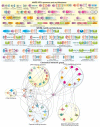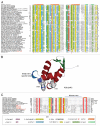The HARE-HTH and associated domains: novel modules in the coordination of epigenetic DNA and protein modifications
- PMID: 22186017
- PMCID: PMC3272235
- DOI: 10.4161/cc.11.1.18475
The HARE-HTH and associated domains: novel modules in the coordination of epigenetic DNA and protein modifications
Abstract
Human ASXL proteins, orthologs of Drosophila Additional Sex combs, have been implicated in conjunction with TET2 as a major target for mutations and translocations leading to a wide range of myeloid leukemias, related myelodysplastic conditions (ASXL1 and ASXL2) and the Bohring-Opitz syndrome, a developmental disorder (ASXL1). Using sensitive sequence and structure comparison methods, we show that most animal ASXL proteins contain a novel N-terminal domain that is also found in several other eukaryotic chromatin proteins, diverse restriction endonucleases and DNA glycosylases, the RNA polymerase delta subunit of Gram-positive bacteria and certain bacterial proteins that combine features of the RNA polymerase α-subunit and sigma factors. This domain adopts the winged helix-turn-helix fold and is predicted to bind DNA. Based on its domain architectural contexts, we present evidence that this domain might play an important role, both in eukaryotes and bacteria, in the recruitment of diverse effector activities, including the Polycomb repressive complexes, to DNA, depending on the state of epigenetic modifications such as 5-methylcytosine and its oxidized derivatives. In other eukaryotic chromatin proteins, this predicted DNA-binding domain is fused to a region with three conserved motifs that are also found in diverse eukaryotic chromatin proteins, such as the animal BAZ/WAL proteins, plant HB1 and MBD9, yeast Itc1p and Ioc3, RSF1, CECR2 and NURF1. Based on the crystal structure of Ioc3, we establish that these motifs in conjunction with the DDT motif constitute a structural determinant that is central to nucleosomal repositioning by the ISWI clade of SWI2/SNF2 ATPases. We also show that the central domain of the ASXL proteins (ASXH domain) is conserved outside of animals in fungi and plants, where it is combined with other domains, suggesting that it might be an ancient module mediating interactions between chromatin-linked protein complexes and transcription factors via its conserved LXLLL motif. We present evidence that the C-terminal PHD finger of ASXL protein has certain peculiar structural modifications that might allow it to recognize internal modified lysines other than those from the N terminus of histone H3, making it the mediator of previously unexpected interactions in chromatin.
Figures



References
-
- Allis CD, Jenuwein T, Reinberg D. Epigenetics. Cold Spring Harbor NY: Cold Spring Harbor Laboratory Press; 2007.
Publication types
MeSH terms
Substances
Grants and funding
LinkOut - more resources
Full Text Sources
Medical
Molecular Biology Databases
Miscellaneous
